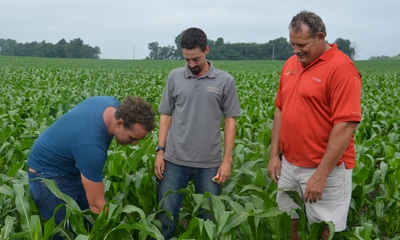
Gerrett Dobson and Mark Kingma are just two of dozens of farmers across the Midwest participating in the Cover Crop Champions project. Financial incentive to participate in the project is provided by the National Wildlife Federation.
“The whole idea is to connect groups of farmers interested in cover crops so they can discuss what works best for them,” explains Dan Perkins, soil conservationist with the Jasper County Soil and Water Conservation District. Perkins is also a local watershed director and Indiana Certified Crop Adviser. Dobson and his partner, Gary Streitmatter, farm near Rensselaer. Kingma farms farther north near DeMotte.

FACE TO FACE: What better place to talk about conservation tillage and cover crops than in a field where cover crops were used? Checking the field are Gerrett Dobson (left), Daniel Perkins and Mark Kingma.
“The concept is that farmer to farmer is the best way to share ideas,” Perkins says. “Smaller groups of farmers meet during the year, and once a year a larger group of farmers gets together to talk."
Recently, Kingma and Perkins visited Dobson and invited Indiana Prairie Farmer along. The idea was to get a taste of how farmers learn by talking among themselves about cover crops.
Here is a portion of that conversation.
Kingma: You can do a nice job with cover crops, but you have to do some management with it.
Perkins: You and Mark are early adopters. That’s why I like to listen to you two talk and see what I can learn.
Kingma: The most valuable part of this one-year [Cover Crop] Champions project was meeting new people. We picked up ideas from early adapters who live in our general vicinity, but not right next door.
Dobson: Some have luck with annual ryegrass, but when I tried it, I just didn’t get a stand.
Kingma: I’ve tried it, too. I got a stand, but the first time I had a little issue burning it down. If I sprayed between 10 a.m. and 2 p.m., it died. It was a warm, early spring. What I sprayed after 2 p.m. was half-dead later on.
Dobson: I would try some other crops besides cereal rye, but it works for me. I like the looks of triticale as a cover crop, but the seed is just too expensive.
Perkins: It has some different properties. It is a cross between wheat and rye.
Kingma: I like to put some radishes in the mix sometimes. They typically winterkill, and you don’t have to kill them in the spring in most years.
Dobson: Going back to triticale, the other thing about it is that it needs to be seeded earlier than cereal rye. It really needs to be seeded in our area by Oct. 15.
Perkins: There are other species you guys have tried or could try, right?
Kingma: Rapeseed might be something to try instead of just cereal rye and annual ryegrass. If going ahead of corn the next year, barley works well. It doesn’t get that tall, and it’s easy to kill.
Dobson: Oats is another one you can try with something else. It winterkills so you don’t have an issue with killing it in the spring.
Perkins: The whole idea of the program is for early adapters like you guys to share experiences like these with those who will be the "middle" adapters. They are the next group who might be just trying cover crops, but who still need advice.
About the Author(s)
You May Also Like




